1 EU ROADTEST: MERCEDES ACTROS 1835LS
Page 36
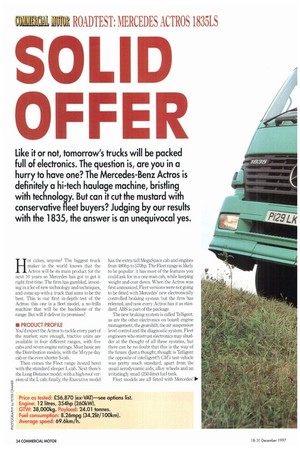
Page 38
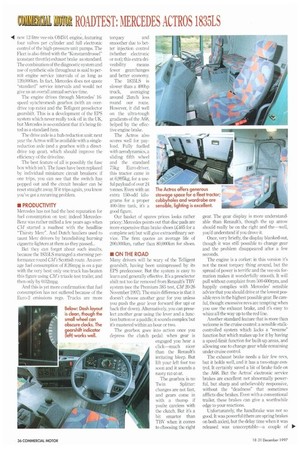
Page 40
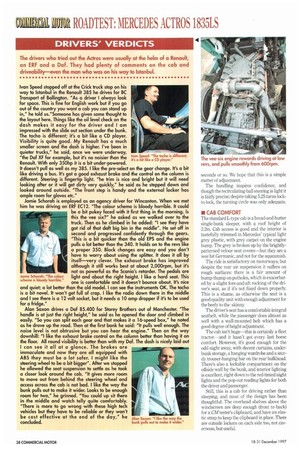
Page 41
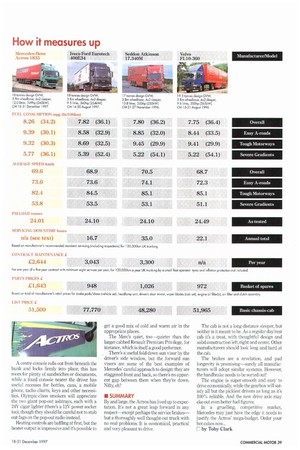
Page 39
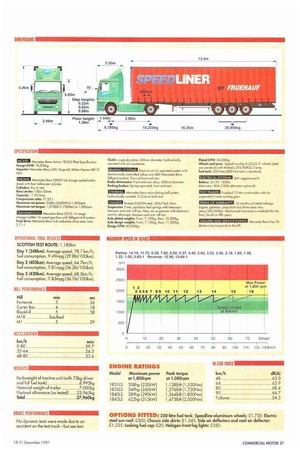
If you've noticed an error in this article please click here to report it so we can fix it.
SOLID OFFER
Like it or not, tomorrow's trucks will be packed full of electronics. The question is, are you in a hurry to have one? The Mercedes-Benz Actros is
definitely a hi-tech haulage machine, bristling with technology. But can it cut the mustard with
conservative fleet buyers? Judging by our results with the 1835, the answer is an unequivocal yes.
Hot cakes, anyone? The biggest truck maker in the world knows that the Actros will be its main product for the next 10 years so Mercedes has got to get it right first time. The firm has gambled, investing in a lot of new technology and techniques, and come up with a truck that aims to be the best. This is our first in-depth test of the Actros: this one is a fleet model, a no-frills machine that will be the backbone of the range. But will it deliver its promises?
• PRODUCT PROFILE
You'd expect the Actros to tackle every part of the market; sure enough, tractive units are available in four different ranges, with five cabs and seven engine ratings. Most basic are the Distribution models, with the M-type day cab or the even shorter S-cab.
Then comes the Fleet range (tested here) with the standard sleeper L-cab. Next there's the Long Distance model, with a high-roof version of the L cab; finally, the Executive model
has the extra-tall MegaSpace cab and engines from 480hp to 570hp. The Fleet range is likely to be popular: it has most of the features you could ask for in a one-man cab, while keeping weight and cost down. When the Actros was first announced, Fleet versions were not going to be fitted with Mercedes' new electronically controlled braking system but the firm has relented, and now every Actros has it as standard. ABS is part of the package.
The new braking system is called Telligent, as are the other electronics on board: engine management, the gearshift, the air suspension level control and the diagnostic system. Fleet engineers who mistrust electronics may shudder at the thought of all these systems, but there can be no doubt that this is the way of the future. Gust a thought, though: is Telligent the opposite of intelligent?) CM'S test vehicle was pretty much standard, apart from the usual aerodynamic aids, alloy wheels and an irritatingly small (250-litre) fuel tank.
Fleet models are all fitted with Mercedes' ■
• new 12-litre vee-six 0M501 engine, featuring four valves per cylinder and full electronic control of the high-pressure unit pumps. The Fleet is also fitted with the "Konstantdrossel" (constant throttle) exhaust brake as standard. The combination of the diagnostic system and use of synthetic oils throughout is said to permit engine service intervals of as long as 120,000km. In fact, Mercedes does not quote "standard" service intervals and would not give us an overall annual service time.
The engine drives through Mercedes' 16speed synchromesh gearbox (with an overdrive top ratio) and the Telligent preselector gearshift. This is a development of the EPS system which never really took off in the UK, but Mercedes is so confident that it's being fitted as a standard item.
The drive axle is a hub-reduction unit: next year the Actros will be available with a singlereduction axle (and a gearbox with a directdrive top gear), which should improve the efficiency of the driveline.
The best feature of all is possibly the fuse box which isn't. The fuses have been replaced by individual miniature circuit breakers: if one trips, you can see that the switch has Popped out and the circuit breaker can be reset straight away If it trips again, you know you've got a recurring problem.
• PRODUCTIVITY
Mercedes has not had the best reputation for fuel consumption on test: indeed MercedesBenz was rather miffed a few years ago when CM started a roadtest with the headline "Thirsty Mere". And Dutch hauliers used to taunt Mere drivers by brandishing burning cigarette lighters at them as they passed...
But they can forget about such insults, because the 1835LS managed a storming performance round GM's Scottish route. An average fuel consumption of 8.26mpg is on a par with the very best: only one truck has beaten this figure using CM's triaxle test trailer, and then only by 0.02mpg
And this is yet more confirmation that fuel consumption has not suffered because of the Euro-2 emissions regs. Trucks are more torquey and smoother due to better injection control (whether electronic or not); this extra dri veability means fewer gearchanges and better economy.
The 1835LS is slower than a 400hp truck, averaging around 2km/h less round our route. However, it did well on the ultra-tough gradients of the A68, helped by the effective engine brake.
The Actros also scores well for payload. Fully fuelled with aerodynamics, a sliding fifth wheel and the standard 75kg Euro-driver, this tractor came in at 6,995kg, for a useful payload of over 24 tonnes. Even with an extra 150-odd kilograms for a proper 400-litre tank, it's a good figure.
Our basket of spares prices looks rather pricey: Mercedes points out that disc pads are more expensive than brake shoes (12465 for a complete set) but will give extraordinary service. The firm quotes an average life of 200,000km, rather than 80,000km for shoes.
• ON THE ROAD
Many drivers will be wary of the Telligent gearshift, having been unimpressed by its EPS predecessor. But the system is easy to learn and generally effective. It's a preselector shift not too far removed from Renault's TM' system (see the Premium 385 test, CM 20-26 November 1997). The main difference is that it doesn't choose another gear for you unless you push the gear lever forward (for up) or back (for down). Alternatively, you can preselect another gear using the lever and a function button or a paddle: it sounds complex but it's mastered within an hour or two.
The gearbox goes into action once you depress the clutch pedal: when gear is engaged you hear a click—much nicer than the Renault's irritating bleep. But lift your left foot too soon and it sounds a nasty rat-at-at.
The gearbox is no Twin Splitter: changes are not fast, and gears come in with a thump if you're careless with the clutch. But it's a bit smarter than 11W when it comes to choosing the right gear. The gear display is more understandable than Renault's, though the up arrow should really be on the right and the—well, you'd understand if you drove it.
Once, very briefly, the display blanked out, though it was still possible to change gear and the problem disappeared after a few seconds.
The engine is a corker: in this version it's not the most torquey thing around, but the spread of power is terrific and the vee-six formation makes it wonderfully smooth. It will pull without complaint from 500-600rpm, and happily complies with Mercedes' sensible advice that you should drive at the lowest possible revs in the highest possible gear. Be careful, though: excessive revs are tempting when you use the exhaust brake, and it's easy to whizz all the way up to the red tine.
Another standard feature that is more than welcome is the cruise control: a sensible stalkcontrolled system which lacks a "resume" function but which makes up for it by having a speed-limit function for built-up areas, and allowing one to change gear while remaining under cruise control.
The exhaust brake needs a fair few revs, but it holds well, and it has a two-stage control, It certainly saved a bit of brake fade on the A68. But the Actros' electronic service brakes are excellent: not abnormally powerful, but sharp and unbelievably responsive, without the "deadness" that sometimes afflicts disc brakes. Even with a conventional trailer, these brakes can give a worthwhile edge to your reactions.
Unfortunately, the handbrake was not so good. It was powerful (there are spring brakes on both axles), but the delay time when it was released was unacceptable—a couple of le seconds or so. We hope that this is a simple matter of adjustment.
The handling inspires confidence, and though the recirculating-ball steering is light it is fairly precise; despite taking 5.25 turns lockto-lock, the turning circle was only adequate.
• CAB COMFORT The standard L-type cab is a bread-and-butter single-bunk sleeper, with a roof height of 3.2m. Cab access is good and the interior is tastefully trimmed in Mercedes' typical light grey plastic, with grey carpet on the engine hump. The grey is broken up by the brightlypatterned velour seat covers—but they are a wee bit Germanic, and not for the squeamish.
The ride is satisfactory on motorways, but despite the rear air suspension it suffers on rough surfaces: there is a fair amount of bump-thump on potholes, which is exacerbated by a slight fore-and-aft rocking of the driver's seat, as if it's not fixed down properly. This is a shame, as otherwise the seat is a good-quality unit with enough adjustment for the beefy to the skinny.
The driver's seat has a comfortable integral seatbelt, while the passenger does almost as well with a wall-mounted belt which has a good degree of height adjustment.
The cab isn't huge—this is certainly a fleet tractor—and it hasn't got every last home comfort. However, it's good enough for the odd night away, with decent curtains, under. bunk storage, a hanging wardrobe and a sturdy trouser-hanging bar on the rear bulkhead. There's also a lockable compartment on the offside wall by the bunk, and interior lighting is excellent, right down to the red-tinted night lights and the pop-out reading lights for both the driver and passenger.
Still, this is a cab for driving rather than sleeping, and most of the design has been thoughtful. The overhead shelves above the windscreen are deep enough (front to back) for a CM tester's clipboard, and have an elastic strap to keep the clipboard in place. There are outside lockers on each side too, not cavernous, but useful.
A centre console rolls out from beneath the bunk and locks firmly into place; this has room for plenty of sandwiches or documents, while a fixed console nearer the driver has useful recesses for bottles, cans, a mobile phone, tacho charts, keys and other necessities. Olympic-class smokers will appreciate the two giant pop-out ashtrays, each with a 24V cigar lighter (there's a 12V power socket too), though they should be careful not to stub out fags on the pop-out radio instead.
Heating controls are baffling at first, but the heater output is impressive and it's possible to get a good mix of cold and warm air in the appropriate places.
The Merc's quiet, too-quieter than the larger-cabbed Renault Premium Privilege, for instance, which is itself a good performer.
There's a useful fold-down sun visor by the driver's side window, but the forward sun visors are some of the best examples of Mercedes' careful approach to design: they are staggered front and back, so there's no apparent gap between them when they're down. Nifty, eh?
• SUMMARY By and large, the Actros has lived up to expectation. It's not a great leap forward in any respect-except perhaps the service brakesbut a thoroughly well thought-out truck with no real problems. It is economical, practical and very pleasant to drive.
The cab is not a long-distance sleeper, but neither is it meant to be. As a regular day/rest cab its a treat, with thoughtful design and solid construction left, right and centre. Other manufacturers should look long and hard at the cab.
The brakes are a revelation, and pad longevity is promising-surely all manufacturers will adopt similar systems. However, the handbrake needs to be sorted out!
The engine is super-smooth and easy to drive economically, while the gearbox will satisfy all but the pickiest drivers as long as it's 100% reliable. And the new drive axle may eke out even better fuel figures.
In a gruelling, competitive market, Mercedes may just have the edge it needs to justify the Actros' mega-budget. Order your hot cakes now...
C by Toby Clark Price as tested: £56,870 (ex-VAT)—see options list. Engine: 12 litres, 354hp (260kW). GTW: 38,000kg. Payload: 24.01 tonnes. Fuel consumption: 8.26mpg (34.214/100km). Average speed: 69.6km/h.
SPECIFICATION
IMIN Mercedes Benz Actras 18354.S Fleet Specification. Design OWN: 18,0006g.
Importer: Mercedes-Benz (UK), Tongwell, Milton Keynes MK 15 BBA.
MR= Mercedes-Benz 0M501 LA charge-cooled turbo diesel with four valves per cylinder Cylinders: Six, in von.
Bore/stroke; 130x I 50mm.
Capacity: 1.95 litres.
Compression ratio: 17.25:1.
Maximum net power: 354hp (260kW) at 1,80Orpm.
Maximum net torque: 1,2761bh (1,730Nm) at 1,08Orpm.
MEM= Mercedes-Benz G210-16 rangechange/sz litter 16-speed gearbox with Telligent shift system. Final drive: Mercedes-Benz hub-reduction drive axle; ratio 3.71:1. Clutch: single dry plate, 430mm diameter, hydraulically operated with air assistance.
FsliESEEMEI Dual.circuit air-operated system with electromcally-controlled wolves and ABS (Mercedes-Benz Telligont system) Discs at front and rear.
Brake dimensions: front and rear discs, 430mm diameter. Parking brakes: Spring-operated, front and rear.
STEERING
hydroJI,cully assisted. 5.25 turns lock-lock. Mercedes-Benz recirculating ball system, SEMI Riveted ESOOTM steel, 283x70x6.7mm. Suspension: Front, parabolic leaf springs with telescopic dampers and onti-roll bar, Rear, air suspension with electronic control, telescopic dampers and DEALERS AND SERVICE POINTS: Mercedes-Benz has 76 dealers/service points in the UK. OPERATIONAL TRIAL RESULTS SCOTTISH TEST ROUTE: 1,180km Day 1 (348km): Average speed, 78.1 km/h; fuel consumption, 9.49mpg (29.8)it/100km). Day 2 (402km): Average speed, 64.7km/h; fuel consumption, 7.81mpg (36.21it/100km). Day 3 (430km): Average speed, 68.5km/h; fuel consumption, 7.83mpg (36.11it/100km). MAXIMUM SPEED IM GEARS Ratios: 14.19, 11.72, 9.58. 7.92, 6.50, 5.37, 4.40. 3.64, 3.22, 2.66, 2.18. 1.80. 1.48, 1.22, 1.00. 0.83:1 Reverse: 12.90, 10.66:1 HILL PERFORMANCE Hill min sec Forteviot 3 26 Carter Bar 4 18 Blackhill 5 38 MI 8 baulked MI 5 29 ACCELERATION km/h secs 0-80 59.7 32-64., 24.3 48-80 33.6 WEIGHTS Kerbweight of tractive unit (with 75kg driver and full fuel tank) 6,995kg Nominal weight of trailer 7,000kg Payload allowance (as tested) 23,965kg Total 37,960kg BRAKE PERFORMANCE No dynamic tests were made due to an accident on the test track—but see text. OPTIONS FITTED: 250-litre fuel tank; Speedline aluminium wheels: £1,730; Electric steel sun roof: 2500; Chassis side skirts: £1,545; Side air deflectors and roof air deflector: 21,225; Locking fuel cap: 220, Halogen front fog lights: 2350. DRIVERS' VERDICTS 11 The drivers who tried out the Actros were usually at the helm of a Renault, an ERF and a Daf. They had plenty of comments on the cab and driveabiliiy—even the man who was on his way to Istanbul. Ivan Speed stopped off at the Crick truck stop on his way to Istanbul in the Renault 385 he drives for BC Transport of Bollington. "As a driver I always look for space. This is fine for English work but if you go out of the country you want a cab you can stand up in," he told us."Someone has given some thought to the layout here. Things like the oil level check on the dash makes it easy for the driver and I am impressed with the slide out section under the bunk. The tacho is different; it's a bit like a CD player. Visibility is quite good. My Renault has a much smaller screen and the dash is higher. I've been in quieter trucks," he said, once we were underway, "the Daf XF for example, but it's no noisier than the Renault. With only 350hp it is a bit under-powered. It doesn't pull as well as my 385. I like the .pre-select on the gear change. It's a bit like driving a bus. It's got a good exhaust brake and the control on the column is different. Steering is fingertip light. "he trim is nice and bright but it will need looking after or it will get dirty very quickly," he said as he stepped down and looked around outside. "The front step is handy and the external locker has ample room for gloves etc." Jamie Schorah is employed as an agency driver for Wincomon. When we met him he was driving an ERF EC12. "The colour scheme is bloody horrible. It could be a bit pukey faced with it first thing in the morning, is this the vee six?" he asked as we walked over to the truck. Then as he climbed in he added: "I see they have got rid of that daft big bin in the middle". He set off in second and progressed confidently through the gears. "This is a bit quicker than the old EPS and the engine pulls a lot better than the 340. It holds on to the revs like a proper 350. Block changes are easy and you don't have to worry about using the splitter. It does it all by itself—very clever. The exhaust brake has improved although it still works best at about 2,000rpm, but it's not as powerful as the Scania's retarder. The pedals are light and about the right height. I like a hard seat. This one is comfortable and it doesn't bounce about. It's nice and quiet; a lot better than the old model. I can see the instruments OK. The tacho is a bit novel. It won't get full of crap. I like the radio down there in the middle and I see there is a 12 volt socket, but it needs a 10 amp dropper if it's to be used for a fridge." Ivan Speed: The loch° is different; it's a bit like a CO player." Jamie Schorah: 'The colour scheme is bloody horrible 'Tags












































































































































